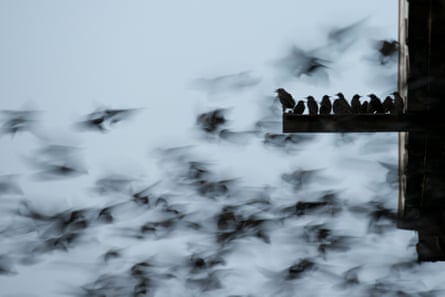Birder
(i.m. my aunt Megan 1924-2009)
I
Midwinter, season for seeing through
Time and space. Before the War,
You were ‘sparrow’. Now I hear
Geese in your breathing, oboe sighs.
Overhead they’re leaving too. Each bird’s
A letter, making sense
For a moment, then not. Cirrus of snow
Lays over the woods. Sluggish
With ice, the creek’s pulse slows.
II
Morning performance on the stage
Under the feeder. Enter wild turkeys,
A corps de ballet in copper tutus.
Solo of startle – entrechat, entrechat,
Pas de bourées – then the tom
Leads off his harem, one by one,
No curtsey, no curtain call. Then gone.
III
Fashion show: a black-eyed junco
Models its species – train,
Down jacket (in white and slate),
Then profile. When I die
I want to hear birds ricochet
Outside my window, feel the strobe
Of small flocks feeding. I’d like
To deserve this litany:
Woodpecker, waxwing, chickadee.
IV
It’s no small thing to have lived your life
In cardinals’ and tree-creepers’ eyes.
They’ll feel you first as a rendezvous missed,
Then hunger. Your body’s the birds
Waiting as they rise and scatter
To a final slam of the kitchen door.

This week’s four-part poem possesses a bright, crisp quality uncharacteristic of the elegiac genre. It’s from the winged and wonderful collection Sparrow Tree, published by Bloodaxe, in which Lewis’s various birds play metaphorical roles while simultaneously remaining perfectly birdlike. The effect is produced by lively tempo, a syntax of flashes and glancings, and some inventive onomatopoeia. Reading the collection, one feels like St Francis as he’s sometimes portrayed – in a whirlwind of quick wings.
Birder is no exception. The brevity of the syntax is almost mimetic. No I, though, allows itself a little extra spaciousness and plangency. The first notes heard in this hushed midwinter, midwest setting, evoke the harsh last struggle for breath: “Geese in your breathing, oboe sighs.” In the tiniest of biographical notes we’re told that Megan, the birder of the title (perhaps it could also allude to the poet), had been nicknamed “sparrow” “Before the War”. So the scene is all set for a death that will incur avian metamorphosis. At this point, though, the woman is also identified with the wintry landscape and the ice-bound creek.
Brevity doesn’t preclude multiplicity of allusion. “Seeing through” has connotations of survival appropriate to someone who lived through the second world war, which would be “the War” to that particular generation. “Letter” might be a letter of the alphabet, but it conjures the epistolary kind, and therefore expands the historical dimension, with letter-writing as a “making sense” now belonging only to the past. “Lays over” suggests the wrap of snow and snow-clouds around the woodland, but perhaps also the singing of funeral lays over the dead.
The next two segments focus on the birds as they arrive at Aunt Megan’s feeder, with the turkeys first in a burlesque corps de ballet, stiff and shiny in their “copper tutus”. The ballet terminology creates visual effects which become auditory in the repetition of “Entrechat, entrechat”. (Entrechat means “interweaving” or “braiding”, “pas de bourées” is a “beating” step which often precedes the pirouette.) The lovely phrase “Solo of startle” works similarly. But it’s all over in a flash: “Then gone”. The finality with which the tom, the male turkey, leads his troupe offstage hints at the abruptness and absoluteness of the moment of death.
After the ballet comes the “Fashion show”, starring a self-consciously elegant dark-eyed junco. It’s as if the anthropomorphism of the theatrical metaphors were a deliberate displacement of emotion from the awful fact of mortality. Perhaps, too, these lines commemorate a fanciful enchantment once shared by the speaker and her aunt as they watched the feeding birds’ daily display.
After the caesura in line 4 of No III, the speaker announces a passionate personal last wish. Elegy invariably performs a double function and turns the elegist’s death-thoughts inwards. In these eloquent lines beginning “When I die”, the birds are more than sensed in their warm-blooded insouciance: they seem a kind of soul-nourishment. “Small flocks feeding” suggests, of course, not only the gathered birds but the enfolding pastoral of the Psalm 23 (“The Lord is my Shepherd”). The quick shift of registers is noteworthy, from the playful literary conceit (and perhaps an echo of Wallace Stevens’s Bantams in Pine-Woods) to the rhythmic intensity of “this litany:/ Woodpecker, waxwing, chickadee.”
No IV braids earlier themes together. It will turn out to be a direct address to Aunt Megan, besides, paradoxically, a confrontation less mediated than before with the fact of death. From the birds’ point of view we feel the desolation of the “rendezvous missed” and the ensuing hunger. Then the narrative flips in a way that may recall that earlier mysterious idea of “seeing through/ Time and space.” The birds flutter away as the woman goes inside, slamming the door after she has filled the feeders (they’ll be back). But there’s surely an exit, too, as if the slammed door stranded her permanently outside.
When the complicating metamorphosis is claimed in “Your body’s the birds”, it seems as if the dead woman has been redistributed among the waiting, rising and scattering birds. It’s a very different “take” on the metamorphoses found in Welsh mythology. Again, there seems to be a feather-flash of biography. The abrupt transition suggests character, somehow: a brisk practicality that may unite Aunt Megan, in her attentiveness to the winter-hungry birds, with her niece, the poet, in her spontaneous-seeming craft of elegy-making.

Comments (…)
Sign in or create your Guardian account to join the discussion